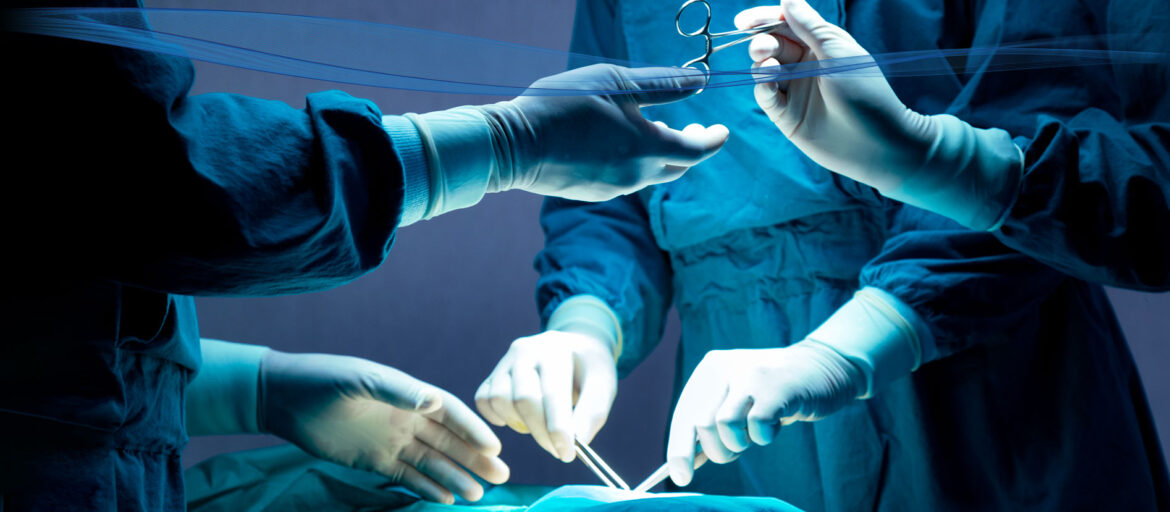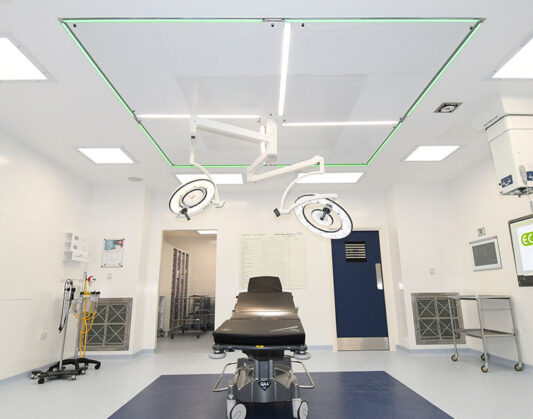

Infection control and prevention
The cost of airborne transmitted infection
In Quality Standard 61, NICE estimates that 300,000 patients a year in England acquire a healthcare-associated infection (HCAI) as a result of care within the NHS.
HCAI places a massive clinical and financial burden on the NHS - it is estimated to cost the NHS in excess of £1 billion annually. It leads to longer hospital stays, costly remedial surgery that puts extra pressure on already busy theatre lists, increased use of antibiotics, and untold distress for the patient and their family.
“Deep wound infection rates for primary hip and knee replacements currently range from 0.5 to 4%. If all hospitals achieved 1% this would transform the lives of 6,000 patients and save the NHS £300m per year.”
Operational Productivity and Performance in English NHS Acute Hospitals, Lord Carter of Coles

Healthcare associated infection (HCAI) and surgical site infection (SSI)
Surgical site infection (SSI) is a type of healthcare-associated infection (HCAI) in which a surgical incision site becomes infected after a surgical procedure. It is associated not only with increased morbidity but also with substantial mortality and places a massive clinical and financial burden on the NHS.
SSI accounts for 15.7% of all HCAI, putting it in the top three after respiratory infections and urinary tract infections. Such is its severity that The Lancet called SSI “the next frontier in global surgery”.
SSI also contributes to antimicrobial resistance (AMR), often referred to as a global crisis. This is because over-reliance on antibiotics contributes to the increased prevalence of antibiotic-resistant bacteria – antibiotics should only be used when essential, in line with the UK Government’s 20-year vision for antimicrobial resistance.
In addition, while antibiotic prophylaxis is effective for preventing SSI in certain procedures, its use carries a risk of adverse effects.

Airborne bacteria in the operating theatre
The air around us is full of particles such as dust, dirt, smoke and liquid droplets. Some of these particles will be bacteria-carrying, also called ‘colony forming units’ (CFUs).
Bacteriologically, the air in an operating theatre is as dirty as the air anywhere else, only it matters more because of what is happing in the space.
The microbiological contamination or bio-burden of the air in the operating room is generally considered a risk factor for SSI, even during surgery on a ‘clean’ wound.
MAT provides highly effective critical ventilation and decontamination solutions designed to eliminate airborne bacteria in the operating theatre suite. In so doing, they improve surgical outcomes and reduce the need for antibiotics.

Infection prevention solutions from MAT
We have been working with the NHS and private Healthcare providers for over 40 years.
To support them, we offer a range of innovative and cost-effective products and services engineered to help reduce the incidence of HCAI and SSI.
ECO-flow ultraclean ventilation canopies
UCV graded airflow design
Ultraclean ventilation (UCV), as utilised in MAT’s ECO-flow ultraclean ventilation (UCV) system, uses graded exponential airflow design to provide ultraclean air (defined in HTM 03-01 as air containing not more than 10 CFU/m3) over the operating or clean zone.
This is a highly effective way to minimise contaminants at the wound site and reduce the incidence of SSI. Its use is recommended in the guidelines contained within HTM 03-01 Specialised Ventilation for Healthcare Premises – Part A (2021).
ECO-flow canopies are available in a range of design options to meet your needs and preferences exactly.
The MAT lay-up cabinet
A sterile field for instruments
The MAT lay-up cabinet creates a sterile field for surgical instrument and prosthetic equipment preparation. The sleek unit can be easily installed in your sterile pack store so there is no theatre downtime. It reduces bioburden and helps in the fight against surgical site infection.
The lay-up cabinet provides approximately 1,000 HEPA-filtered air changes per hour and a 1,000mm safe working zone. It is fully self-contained and has low running costs. It is easy to fit, requiring only a 13amp power supply and taking up as little as 1.4m of wall space (depending on unit chosen).
Mobile laminar flow solutions
MAT is the UK distributor for the Toul Meditech range of mobile laminar flow solutions
When surgical instruments have been laid out and are awaiting use, up to 50% of their surface area is exposed to the air, providing an ideal place for CFUs to settle. These bacteria are then transferred directly from the surgical instrument to the wound site.
We offer a range of solutions to address this:
- Steristay mobile instrument table - delivers ultraclean air via laminar flow around the surgical instruments
- Operio Ceiling and Operio Mobile units - can be used in conventional operating theatres (i.e., those without an ultraclean ventilation canopy) to deliver ultraclean air over the wound site
The units HEPA filter 400m3/hour of air (approx) and provide a 1.2m length of sterile field (approx) and have a multitude of uses:
- Protection of patient wound site
- Protection of surgical instruments - prosthetics, implants, catheters, stents, grafts, etc
- Vascular and interventional radiological procedures - EVAR, FEVAR, TEVAR, TAVI, etc
- Cath lab procedures - angiogram, angioplasty, ablation, fitting pacemakers, etc
- Major surgery - orthopaedics, maxillofacial, ophthalmic
- Minor surgery - cataracts, plastic, dental, etc
- Minimally invasive surgery - arthroscopy, laparoscopy, etc
- Minor procedures – bone marrow harvest, injections, biopsies, Hickman line, PICC line, etc
- Supporting critically ventilated rooms currently failing annual verifications
- Misappropriation of room classification, such as treating SPS as lay-up preparation rooms or treatment rooms as operating rooms
- Clinical overflow, such as treatment rooms now being used for invasive surgical procedures
Hydrogen peroxide decontamination
Touchless delivery system
MAT FM offers touchless hydrogen peroxide decontamination of operating theatres, recovery areas, critical care, sterile services, aseptic suites, cleanrooms, containment laboratories and all critically ventilated departments. The system always kills 99.99% of harmful pathogens (4-log kill) and achieves 99.999% on C.diff and Geobacillus (6-log kill).
The decontamination can be carried out by our trained service engineers prior to handover of a completed new build or refurbishment project, or as part of a regular periodic maintenance proposition, or as an emergency call-out.
Contact us for more information on this and the many other facilities management services available.
MAT FM maintenance and service
Expert facilities management service
Our facilities management division offers validation, verification, service packages or one-off maintenance visits that keeps your critical ventilation system compliant and operational, providing a safer environment for patient care.
In addition to the ECO-flow, we service UCV canopies provided by any other manufacturer.
Contact us for more information on the many facilities management services offered by MAT FM.
"I have been involved in a cleanroom project with MAT over the last few years and I am very satisfied with the final product. I found the MAT team to be responsive, and any issues were dealt with quickly. I would certainly use them again."
Helen-Marie Cripps: Radiopharmacy Product Manager, Brighton 3Ts


